If you are looking for strategic planning concepts to include in your management toolbox, you came to the right place.
This strategic planning guide was developed as a reviewer for a comprehensive exam of an MBA program.
Strategic Planning Table of Contents
Management
Strategy
Porter’s Five Forces Theory of Industry Structure
Generic Strategies
Strategy As Part Of An Organization: The Seven S Model
The Value Chain and Integration
The Ansoff Matrix (Expansion Strategy)
Competitive Tactics: Signaling
Portfolio Strategies
Strategy Implementation
The Roles of the CEO
Organizational structure and controls
Building Organizational Capabilities
Strategy and Organizational Planning
Leadership, Ideology and Organizational Culture
Lecture Notes on Organizational Culture
Politics, Power, and Influence in organization
Power and Politics
[Bonus]: Managing your Boss
International Expansion
Management
The foundation of strategic planning is always management. You need to understand management first before you can develop correct strategies for your business.
Definitions of Management
- The efficient allocation of resources to achieve a given set of objectives. • “The supervising or directing of an enterprise.”
- The process of leading and directing all or part of an organization, often a business, through the deployment and manipulation of resources (human, financial, material, intellectual or intangible).
- The activity of getting things done with the aid of people and other resources
- Effective utilization and coordination of resources such as capital, plant, materials, and labor to achieve defined objectives with maximum efficiency
Functions of Management
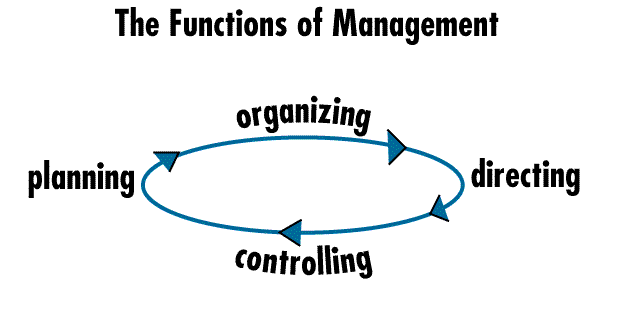
Planning
- Entrepreneurial function
- Identification of a deliberate end
- At the top level, requires an assessment of stakeholder needs
Organizing
- Assessment of available resources
- Identification of other strategic assets
Directing •
- Leading, guiding, motivating, and actuating the efforts of employees
- Management has to do with power by position, whereas leadership involves power by influence
Controlling
- Establishing sound feedback mechanisms
- Ensuring that plans come to fruition
- And if results do not match plans, determining steps to adapt accordingly
Strategy
- A way to achieve (and hopefully sustain) a competitive advantage
- Top management’s plans to attain outcomes that are consistent with the mission and goals of the organization
Strategic Management
- Broader than just strategy
- Top management centric
- Involves understanding the environmental situation and then formulating and implementing strategies
Strategic Management Process
- External Analysis
- Internal Analysis
- Strategy Formulation
- Strategy Execution
- Strategic Control
5 Ps of Strategy
Strategy as a Plan
- Following what’s on paper.”
- Documented (or not), the plan is intentional, premeditated
- Strategic planning documents
Strategy as a Pattern
- Doing what works.
- Borne from previous successes that become habitual behavior. E.g. Jollibee acquires Greenwich, then Chowking, then Red Ribbon. What next?
Strategy as a Position
- Being true to our identity.”
- What you want to be known for
- Consistency to projected identity – Product positioning strategies
- Price/value positions
Strategy as a Perspective
- Being true to what we believe in.
- Having a different world-view than others
- Willingness to stretch the limits of the law
- Idealism
- Beliefs and attitudes cannot be changed
Strategy as a Ploy
- “Disrupting the playing field.”
- Doing something “unthinkable” in order to confuse or divert or attract attention
Levels Of Strategy
There are three levels of strategy to be considered: •
Functional Strategy (The value activities engaged in)
Functional strategies are those operational methods and “value-adding” activities that management chooses for its business.
Business Strategy (How to fight the competition, tactics)
Business strategies are those battle plans used to fight the competition in the industry that a company currently participates in.
Corporate Strategy (What businesses should I be in?)
The corporate strategy looks at the whole gamut of business opportunities.
Theoretical Perspectives
Examples of Deliberate vs. Emergent Strategies
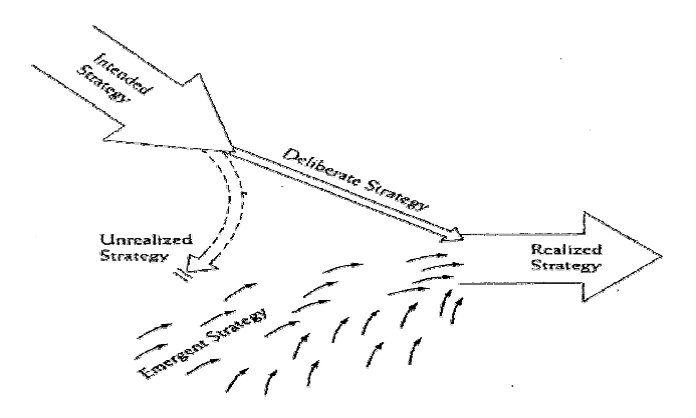
- Globe Telecom – In late 1990s, intended to compete via quality of digital services, ended up competing by text messaging
- Pepsi Cola – In US, spent decades trying to compete by price, ended up winning through segmentation
Theoretical Perspectives
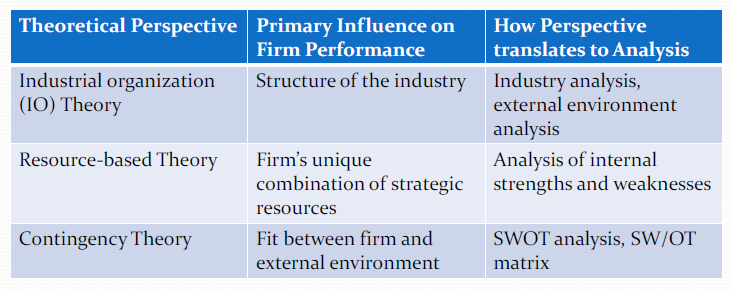
I/O Theory
- Industrial Organization model of above-average returns
- Assumes that it is the external environment that most affects firm performance
- Firm performance determined by economies of scale, barriers to entry, etc.
- Grounded in economic theory
Resource-Based Theory
- Performance is a function of a firm’s resources and its ability to utilize these
- Unique combination of resources and utilization strategies equals distinctive competence for the firm
- Competitive Advantage
Contingency Theory (Institutional View)
- Firms which best fit the environment become the most profitable firms
- Organizational performance is a function of both environmental forces and the firm’s strategic actions
- Effective firms seek to match their resources with the best environments for them
Strategic Thinking vs Strategic Planning
| Strategic Thinking | Strategic Planning | |
| Vision of the Future | Only the shape of the future can be predicted. | A future that is predictable and specifiable in detail. |
| Strategic Formulation and Implementation | Formulation and implementation are interactive rather than sequential and discrete. | The roles of formulation and implementation can be neatly divided. |
| Managerial Role in Strategy Making | Lower-level managers have a voice in strategy-making, as well as greater latitude to respond opportunistically to developing conditions. | Senior executives obtain the needed information from lower-level managers, and then use it to create a plan which is, in turn, disseminated to managers for implementation. |
| Control | Relies on self-reference – a sense of strategic intent and purpose embedded in the minds of managers throughout the organization that guides their choices on a daily basis in a process that is often difficult to measure and monitor from above. | Asserts control through measurement systems, assuming that organizations can measure and monitor important variables both accurately and quickly. |
| Managerial Role in Implementation | All managers understand the larger system, the connection between their roles and the functioning of that system, as well as the interdependence between the various roles that comprise the system. | Lower-level managers need only to know his or her own role well and can be expected to defend only his or her own turf. |
| Strategy Making | Sees strategy and change as inescapably linked and assumes that finding new strategic options and implementing them successfully is harder and more important than evaluating them. | The challenge of setting strategic direction is primarily analytic. |
| Process and Outcome | Sees the planning process itself as a critical value-adding element. | The focus is on the creation of the plan as the ultimate objective. |
Strategy as Learning
In 1990, Peter Senge, who had collaborated with Arie de Geus at Dutch Shell, popularized de Geus’ notion of the “learning organization“. The theory is that gathering and analyzing information is a necessary requirement for business success in the information age. To do this, Senge claimed that an organization would need to be structured such that:
- People can continuously expand their capacity to learn and be productive.
- New patterns of thinking are nurtured.
- Collective aspirations are encouraged.
- People are encouraged to see the “whole picture” together.
Senge identified five disciplines of a learning organization. They are:
Personal responsibility, self-reliance, and mastery
We accept that we are the masters of our own destiny. We make decisions and live with the consequences of them. When a problem needs to be fixed, or an opportunity exploited, we take the initiative to learn the required skills to get it done.
Mental models
We need to explore our personal mental models to understand the subtle effect they have on our behavior.
Shared vision
The vision of where we want to be in the future is discussed and communicated to all. It provides guidance and energy for the journey ahead.
Team learning
We learn together in teams. This involves a shift from “a spirit of advocacy to a spirit of inquiry”.
Systems thinking
We look at the whole rather than the parts. This is what Senge calls the “Fifth discipline”. It is the glue that integrates the other four into a coherent strategy.
an alternative approach to the “learning organization”
Geoffrey Moore (1991) and R. Frank and P. Cook also detected a shift in the nature of competition. Markets driven by technical standards or by “network effects” can give the dominant firm a near-monopoly. The same is true of networked industries in which interoperability requires compatibility between users.
Examples include Internet Explorer’s and Amazon’s early dominance of their respective industries. IE’s later decline shows that such dominance may be only temporary.
Moore showed how firms could attain this enviable position by using E.M. Rogers’ five stage adoption process and focusing on one group of customers at a time, using each group as a base for reaching the next group. The most difficult step is making the transition between introduction and mass acceptance. (See Crossing the Chasm).
If successful a firm can create a bandwagon effect in which the momentum builds and its product becomes a de-facto standard.
Strategic Planning Tool: Porter’s Five Forces Theory of Industry Structure
Michael Porter of Harvard has developed the Five Forces Theory of Industry Structure to help companies survive in a competitive environment.
Porter’s theories can be used to formulate survival strategies for your current business, as well as to evaluate the “attractiveness” of other industries for expansion.
Porter offers tools for investigating the five forces that determine the level of competition, and consequently, the level of profit in an industry. The five forces that drive industry competition are:
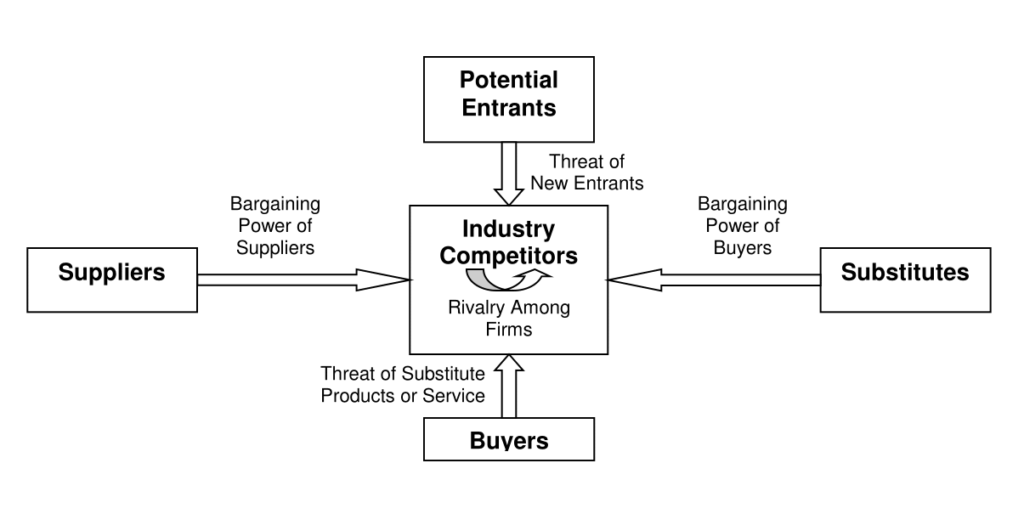
Threat of Substitutes
- Determinants of Substitution Threat
- Relative price performance
- Switching costs
- Buyer propensity to substitute
Threat of New Entrants
- Entry Barriers
- Economies of Scale
- Proprietary product differences
- Brand identity
- Switching costs
- Capital requirements
- Access to distribution
- Absolute cost advantages
- Proprietary learning curve
- Access to necessary inputs
- Proprietary low-cost product design
- Government policy
- Expected retaliation
Bargaining Power of Suppliers
- Determinants of Supplier Power
- Differentiation of inputs
- Switching costs of suppliers and firms in the industry
- Presence of substitute inputs
- Supplier concentration
- Importance of volume to supplier
- Cost relative to total purchases in the industry
- Impact of inputs on cost or differentiation
- Threat of forward integration relative to the threat of backward integration by firms in the industry
Bargaining Power of Buyers
- Determinants of Buyer Power
- Bargaining Leverage
- Buyer concentration versus firm concentration
- Buyer volume
- Buyer switching costs relative to firm switching costs
- Buyer information
- Ability to backward integrate
- Substitute products
- Pull-through
- Price Sensitivity
- Price/total purchases
- Product differences
- Brand identity
- Impact on quality/performance
- Buyer profits
- Decision-makers’ incentives
The intensity of Rivalry Among Competitors
- Rivalry Determinants
- Industry growth
- Fixed (or storage) costs/value-added
- Intermittent overcapacity
- Product differences
- Brand identity
- Switching costs
- Concentration and balance
- Informational complexity
- Diversity of competitors
- Corporate stakes
- Exit barriers
Porter focuses on power, the ability of one participant in the value chain to force its will on others in the chain.
The industry’s competitive intensity results from all five forces exerting their pressures on the industry. The model offers insight on how to compete more effectively within one’s own industry.
The forces at play in an industry are dynamic.
The essence of strategy is to understand the current forces and to use them to your advantage.
Generic Strategies
A Generic Strategy is one that can be used across many industries. Porter has aptly captured the three major strategies in a matrix of functional and business strategic possibilities:
Cost Leadership
By achieving the lowest cost of production in an industry, a company can either reduce its prices or keep the increased profits to invest in research to develop new and better products. Low-Cost Producers (LCP) can also choose to use their profits to advertise and market their products more vigorously. An operations concept related to cost leadership is economies of scale. This means that as one produces more, costs per unit fall. These “learning” efficiencies can come from six sources:
- Labor Efficiency – learning through repetition or automation
- New Processes and Improved Methods – less costly ways to do the same task
- Product Redesign – redesign to lower costs of materials and labor
- Product Standardization – decreasing the variations of a product’s components
- Efficiencies of Scale – doubling factory capacity does not cost twice as much
- Substitution – using less expensive but adequate materials
To be useful, the learning concept must be quantifiable. The learning curve, sometimes called the experience curve, was developed by the Boston Consulting Group in the 1960s to attach numbers to economies of scale benefits believed to exist.
They found that each time the “cumulative” volume of production doubled the cost of manufacturing fell by a constant and predictable percentage.
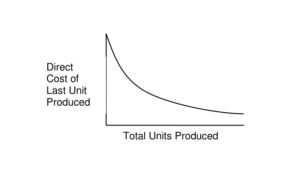
The important point to remember is that “accumulated production” starts with unit one, not the first produced that month or year, but the very first one off the assembly line using that manufacturing method. The strategic implications of the learning curve lie in moving down the learning curve before competitors do.
As a product matures in its product life cycle and becomes widely adopted, the curve becomes less useful.
Learning curves are not static. A new process or material may increase worker productivity and thus alter the curve.
That is called jumping to a new curve. In this situation, the running total of accumulated units produced is set to zero, and a new curve takes effect. With products that are continuously innovated, the learning curve is of little use. New curves are formed all the time, and there is not much time to “move down” any of them.
Differentiation
Differentiation is a prime marketing objective.
It involves making your product or service appear different in the mind of the consumer. With products, this means offering better:
- Design;
- Reliability;
- Service; and
- Delivery.
With services, a point of differentiation can be employee courtesy, availability, expertise, and location. Products and services can be differentiated via advertising, even if they are virtually the same.
Focus
Using a focus strategy, a company concentrates on a market area, a market segment, or a product.
The strength of a focus strategy is derived from knowing the customer and product category very well.
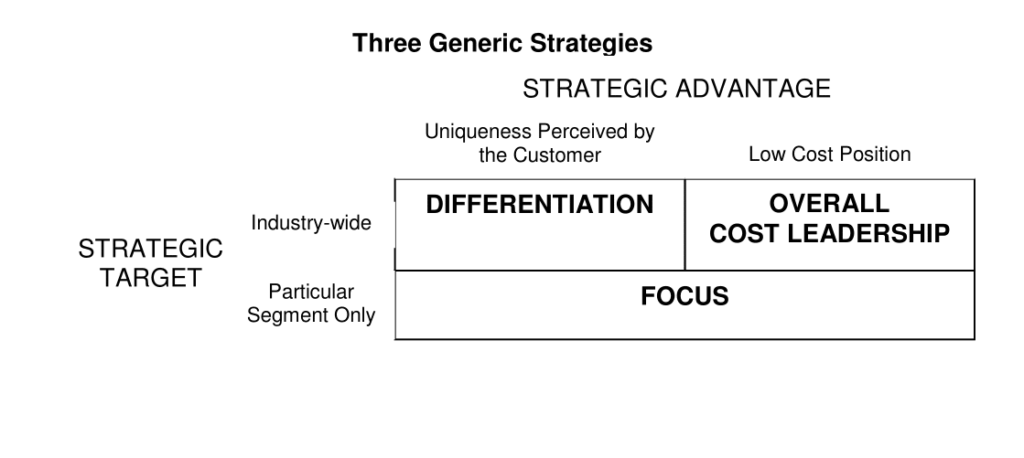
Strategy As Part Of An Organization: The Seven S Model
Two separate stages characterize strategic planning: formulation and implementation.
Thomas J. Peters, of In Search of Excellence fame, created the Seven S model showing that strategy ought to be interwoven within the fabric of an organization. Peters created the model with Robert H. Waterman and Julian R. Philips.
Their model provides a structure with which to consider a company as a whole so that the organization’s problems may be diagnosed and a strategy may be developed and implemented. If a strategy requires radical reorganization, it’s called reengineering. If not, it is described as “organizational tinkering”.
The Seven S’s are:
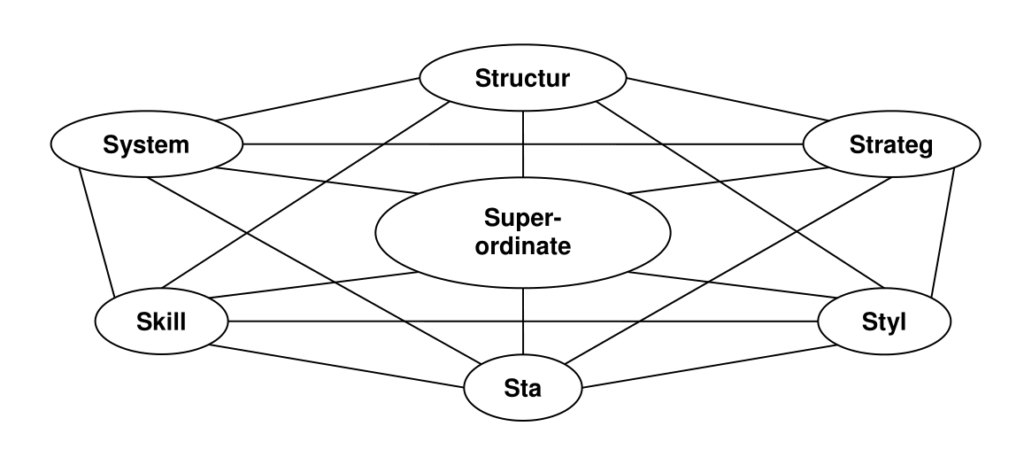
The diagram illustrates the “multiplicity” and “interconnectedness” of elements that influence an organization’s ability to change. There is “no starting point or implied hierarchy”. In an “excellent” organization, each of the S’s complement the others and consistently advances the company’s goal.
Structure
A corporation’s structure affects its strategic planning and its ability to change. A company’s structure may have a customer or a geographic focus.
Strategy
This refers to the actions that a company plans in response to or in anticipation of changes in its external environment, its customers, and its competitors.
Style
Culture or style is the aggregate of behaviors, thoughts, beliefs, and symbols that is conveyed to people throughout an organization over time. Since it is very hard to change a company’s ingrained culture, it is important to bear it in mind when developing a new strategy.
Staff
By staff, Peters means the human resource systems, which include appraisals, training, wages, and intangibles such as employee motivation, morale, and attitude. Without employee cooperation, a company will not have the ability to succeed.
Skills
Closely related to staff are the distinctive abilities and talents that a company possesses. Skills may range from the ability of staff to speak a foreign language to an understanding of statistics, to computer literacy, for instance.
Systems
The procedures, both formal and informal, by which an organization operates and gathers information, constitute the systems of a company. With this S, Peters is concerned with the systems that allocate and control money and materials as well as gather information.
Superordinate Goals
Super-ordinate goals are the guiding concepts – values and aspirations, often unwritten – that go beyond the conventional statements of corporate objectives. “Super-ordinate goals are the fundamental ideas around which a business is built.” Mission statements are often mentioned when companies speak about their goals.
A mission statement should be a short and concise statement of goals and priorities. The wording of the mission statement is often crafted to address the most important constituency at the time. Apart from the politics involved in its creation, a mission statement can be a useful super-ordinate goal, if it doesn’t have one.
The Value Chain and Integration
Value Chain
The next step for a strategic analyst is to assess the value a company adds to its products.
At each link in the chain, a channel participant (internal or external) adds value to the products as it makes its way to the consumer.
Supplier Value Chain > Firm Value Chain > Channel Value Chain > Buyer Value Chain

Strategic analysts review industries’ value chains to identify current and future sources of competition.
Integration
Forward and Backward Integration
When a company operates in areas further down the value chain, it is said to be forwardly integrated toward the consumer. If a business operates in areas closer to raw materials, then the company is said to be backwardly integrated. You can see a company as either forwardly or backwardly integrated depending on the point in the value chain at which you view that company.
Vertical and Horizontal Integration
Vertically integrated is a term used for companies that participate at many levels of the value chain in an industry. The term can describe both forwardly and backwardly integrated companies. The key is that several value-adding functions are being performed by one firm. Horizontal integration occurs when, for instance, a company acquires a competitor at the same level in the value chain.
Integration strategies may result in obvious benefits such as secured inputs and lower costs, but the disadvantages include higher exposure to the downturns in a single industry.
The Ansoff Matrix (Expansion Strategy)
H.I. Ansoff created it in 1957 as a clear way to classify routes for business expansion. What determines the strategy classification is the newness of the product to the company and the firm’s experience with the intended market.
The “newness” of the product or market is determined by how “new” it is to the company contemplating the strategy, not by the age of the product or market itself.

Competitive Tactics: Signaling
Signaling is a key strategic tool.
It involves letting your competitors know what’s on your mind. Combatants signal what they plan to do or what steps they will take in response to a competitor’s move. Signaling is used to prevent disastrous (and costly) price wars.
Six comment types of legal signals are:
Price Movements – to signal intentions and to penalize unacceptable behavior
Prior Announcements – to threaten, to test competitor’s resolve, and to avoid surprises
Media Discussions – to communicate your rationale for actions and to convey your thoughts to the competition
Counterattack – to hit your competitor’s home market with a price cut or promotion in retaliation for their encroachment on your turf
Announce Results – to communicate clearly to the competition the results of an action to avoid a costly misunderstanding
Litigation – to tie up a competitor in court
Game Theory – Game Theory is the formal study of competitive interactions. It analyzes possible outcomes in situations where people are trying to score points from each other. You do this by trying to anticipate the reactions of your competitor to your next move and then factoring that reaction into your actual decision.
Portfolio Strategies
A portfolio strategy is considered the highbrow area of corporate-level strategic planning. Theoretically, if a corporation could put together the right portfolio of unrelated and countercyclical businesses, it would be immune to economic downturns. However, this is only in theory, and in real-world settings, it’s not as simple.
Corporations want to know what business they should be in, which they should continue in, and which they should sell.
The Boston Consulting Group’s Growth/Share Matrix
The Boston Consulting Group (BCG) model uses market growth rates and relative market share to classify companies into four categories. Their studies showed that high market share was highly correlated with higher ROI (return on investment) and lower costs because of learning curve effects.
Therefore, the theory suggests that it is best to have a stable, high market share in some businesses to fund the cash needs of other businesses. There are four classifications that rest on that premise.
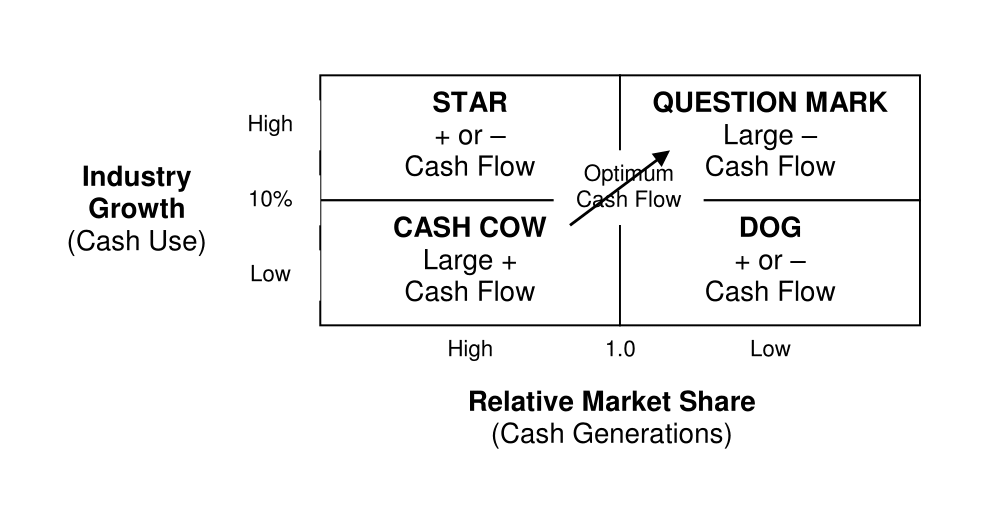
Star – The Star is a high-market-share business in a high-growth industry. Stars grow and finance themselves. Characteristically, these types of companies exist in competitive markets and they require vigilant management in order to maintain their enviable positions on the BCG matrix.
Cash Cows – Cash Cows are high-market-share businesses in low-growth industries. These gems provide the cash to fund other businesses.
Dogs – Dogs are a small-market-share business in low-growth industries. These businesses are going nowhere and consumer corporate ash and management’s time in an attempt to stay competitive. Dogs are not necessarily bad businesses. They just aren’t the type of businesses that large corporations want in their portfolio.
Question Marks – Question Marks are small-market-share businesses in high-growth industries. To grow they need cash. If they become successful, they will become stars, and later, cash cows. If they fail, they either die or become dogs as their industries mature.
Portfolio strategies have their drawbacks. They assume that businesses in a portfolio have no significant linkages, which is often not the case. Many collections of businesses share technical, marketing, and support functions.
McKinsey & Company’s Multifactor Analysis
The model has two general variables that govern a business evaluation: industry attractiveness and business strength. Each variable is determined by a number of industry factors. In any given industry, some factors will be of greater importance than others. The six generic courses of action dictated by the model are:
- Invest and Hold
- Invest to Grow
- Invest to Rebuild
- Selectively Invest in Promising Areas of the Business
- Harvest, Milk the Cow
- Divest, Sell the Dog
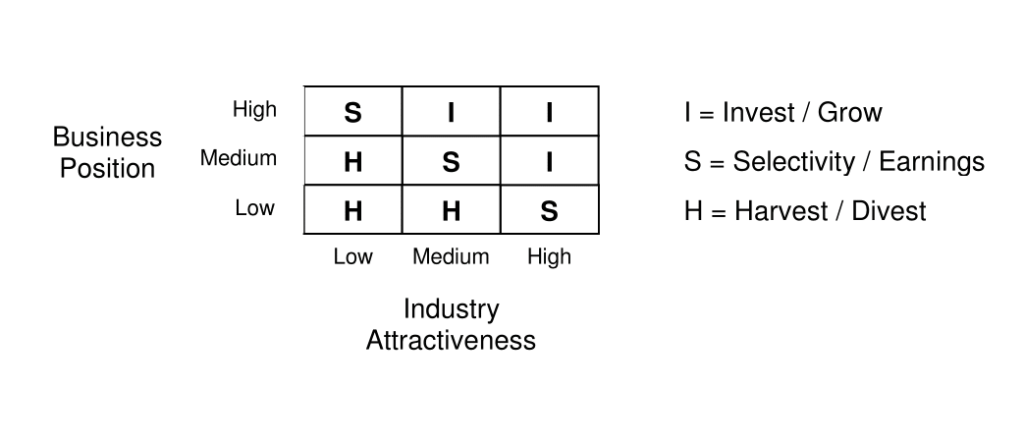
Although the McKinsey model is attractive because it takes into account many factors, nonetheless the evaluation is subjective.
Arthur D. Little’s SBU System
Arthur D. Little (ADL) has cooked up a system that revolves around the SBU, the strategic business unit. When similar businesses of a corporation are grouped into SBUs, portfolio strategies become less complicated because there are fewer units to worry about.
Businesses in different SBUs have little association with one another other than the financial ties imposed on them by the parent corporation. The ADL portfolio process has four steps:
- Classify all the businesses of a corporation into SBUs.
- Place the SBUs into a matrix
- Evaluate the conditions of the industries in which each SBU operates
- Make a decision
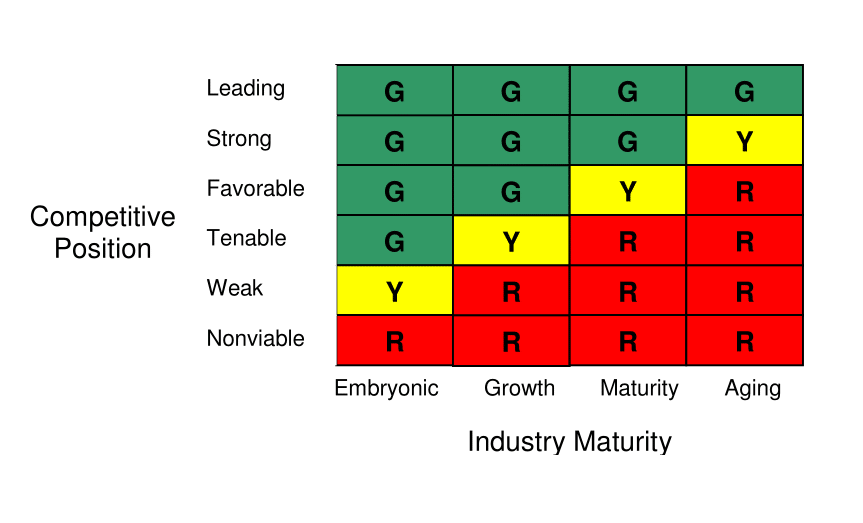
The two variables that are operative in ADL’s model are industry maturity level and competitive position. The consultants devise appropriate strategies for each SBU owned: Build, Maintain, or Liquidate.
For green SBUs there are many different strategies available. For the red ones, the options available are constrained by the pool “conditions” in which they find themselves.
Once the SBU is classified, the consultants turn to their palette of generic strategies such as focus, penetration, or diversification to construct appropriate tactical plans.
Strategy Implementation
Concerns of a General Manager or CEO:
- Human Resource Development
- Organizational Structure
- Management Control Systems
- Organizational Culture
- Politics and Regulatory Issues
- Organizational Change and Renewal
The issues and concerns that a CEO or general manager must address in strategy implementation were presented separately and by topic in this paper. In real business situations, the CEO is faced with issues at the same time and may even be recurrent, and changing depending on the internal and external environment of the firm.
The point is that the leader of the organization cannot assume that there is a definite end to the resolution of issues. Thus, a leader of the organization needs to have a management team that will assist him in the implementation of strategies.
Human Resource Development
HRD programs should be designed for personnel to ensure management that employees and management staff have the appropriate skills and training required to accomplish corporate strategies. Selected HRD issues that a training program should address:
- Short term Needs (within 60 Days)
- Entry Level Programs
- Training programs for new regulations that impact the firm
- Training programs for salesforce
- Long Term Needs
- Cost leadership – cost analysis, product costing, cost allocation, production processes, etc
- Market Leadership – product development, market research, consumer behavior, economics, and industry analysis
- Globalization of Business/ Expansion
- Short term and long term HRD programs for personnel that are hired in foreign countries or local personnel assigned to work in foreign countries (language, foreign laws, marketing in a foreign country)
- Technological Issues
- Job redesign, enrichment or creation of new positions for the advancement of technology
- Changes in job specifications (short- and long- term) for continuing operations despite advancement in technology
Organizational Structure
Multi-Divisional Structure – a corporation has an operating division that is responsible for profits and at the corporate level, there are organizational units or departments that provide centralized organizational functions such as HRD, Finance, Legal and Accounting
Holding Companies – Own shares in subsidiary corporations and control is done through board members and appointed corporate officers of subsidiaries like president and treasurer
Organizational Change and Renewal
How to manage organizational change:
Establish a sense of urgency
- Form a powerful guiding coalition
- Listen to the opposition/dissenting opinions to ensure proposed changes are validated
- Given them key performance indicators/targets/controls
Create the vision
- Give/provide motivation
- Incentives for change
Communicate the vision
- Empower people to act on the vision
- Create short-term wins, with big goals that can be achieved long-term
- Based on targets/milestones, set short-term goals to be achieved
Institutionalize New Approaches
Reengineering – Fundamental rethinking and radical redesign of business processes to achieve dramatic improvements in critical, contemporary measures of performance, such as cost, quality, service and speed
Incrementalism – Large companies utilize processes as they manage complex strategy shifts. Strategic changes process are fragmented, evolutionary and intuitive – Unstructured and no rigid timetable, thus dynamic (no definite beginning or end)
Organizational Culture
Basic assumptions that are shared by a group and which have been found to be valid in the past so they can be taught to newcomers in the organization.
People and organization leaders create and change the culture.
Leaders, particularly visionary and articulate leaders, define and institutionalize the organization’s culture
Key Functions:
- External adaptation/survival
- Internal integration problems
- Sense of identity for the firm
Management Control Systems
Designed to address agency problem to minimize the gap between the individual manager’s goals and organization’s goals.
Key elements:
Management Control Structure
| Type | Selected Criteria for Performance Measurement |
| Revenue Centers | Revenues or Market Share |
| Discretionary Cost Centers | Costs vs Accomplishments |
| Engineered Cost Centers | Actual costs vs Standard Costs |
| Profit Centers | Sales Minus Costs and Expenses |
| Investment Centers | Return on Investments |
Management Control Process
- Determination of criteria or measures against which unit’s performance is measured
- Measurement, reporting, and review of performance in relation to the above criteria
- Reward managers of key operating units based on performance
Politics and Organizational relationships
Internal organizational relationships that must be managed and dealt with within an organization are as follow:
- President and the Board
- Line and staff personnel
- Departmental relationships
- Marketing and Production
- Marketing and Accounting
- HR and other departments
- Boss and subordinate relationships
- Union and Management
Likewise, the relationship of the firm with external organizations must be managed and dealt with management. Some of these are:
- Firm and supplier relationship
- Firm and customer relationship
- Management and owners relationship
- Firm and politicians, congress, government, public agencies (BIR, SEC, BSP), activists, supreme court, media
- Dealing with regulatory agencies
Regulatory Issues
Laws and regulations impact on the operations of the business firms.
In the Philippines, some industry sectors are regulated. Extent and control by regulatory agencies vary for each industry.
- Water Utility – Manila Water Sewerage System,
- Power Distribution – Energy Regulatory Commission
- Banking – Bangko Sentral ng Pilipinas
- Insurance – Insurance Commission
- Telecom – National Telecommunication Commission
- Others – BIR, SEC, DTI
The Roles of the CEO
According to Erlinda Echanis, professor emeritus at the UP College of Business Administration from the University of the Philippine Diliman, the main objective os the CEO is to drive the business from the current situation (status quo) to the destination (vision). The CEO act as the driver of the vehicle (the business).
In order to do so, the CEO must not rely on the tools of strategic planning. The CEO must determine the CRITICAL SUCCESS FACTORS that are the determinants of success. 80% of the results are driven by 20% of the factors. Correctly identifying the 3 best critical success factors of any business shall greatly simplify the strategic planning process of the business.
By conducting a gap analysis of the status quo and the vision based on the critical success factor, the CEO has the lead on what to prioritize on the strategic plan that will minimize the gap between the goals and the existing capabilities/state of the company.
In the process, the CEO may have the need to fire employees and managers.
Set up high standards that are appropriate to establish a culture of winning. With that said, the CEO job demands successful action in a variety of roles that differ according to the nature of the problem observed or decision pending, the needs of the organization or the personality and style. The CEO may have the need to preside over technical capabilities that they cannot possibly have personal expertness. This includes the know-how on markets and ways in which they are changing
CEOs are obliged to put behind specialized apparatus their education and functional experience have provided.
E.g. engineers running their companies strictly as engineers will encounter financial and marketing problems
The behavior of a CEO for Strategic Planning
Interpersonal
- Figurehead – for ceremonial duties
- Leader – of the work of organization and unit
- Liaison agent – contacts outside his unit
Informational
- Monitor – of information
- Disseminator – internally
- Spokesman – spokesman (externally)
Decisional
- Entrepreneur
- Disturbance handler
- Resource allocator
- Negotiator
Roles of the CEO
Organization leader
Organization leader requires securing the attainment of planned results in the present and developing an organization capable of producing both technical achievement and human satisfactions. It also involves planning and executing policy decisions affecting future results. The functions to become an organizational leader are as follows:
- First function: Achieving acceptable results against expectations
- Requires CEO to be continually informed and ready to intervene when results fall below what had been expected.
- Changing circumstances and competition produce emergencies upsetting well-laid plans
- Requires resourcefulness in responding to a crisis
- Second function: creative maintenance and development of the organized capability that makes achievement possible
- Integration of the specialist functions which enable their organizations to perform the technical tasks in marketing, R&D, manufacturing, finance, control and personnel, which proliferate as technology develops and tend to lead the company in all directions
- Skills required by these functions:
- Taskmaster – must go beyond insistence upon achievement of planned results
- Mediator
- Organization designer
- Need ability in the education and motivation people and the evaluation of their performance
- Show itself in the formal organizational designs which are put into effect as the blueprint of the required structured cooperation
- Perspective demanded: embraces both the primacy of organizational goals and the validity of individual goals
- Exhibit impartiality toward the specialized functions and have criteria enabling them to allocate organization resources against documented needs
Personal leader
CEO as a personal leader role requires making a distinctive personal contribution. The behavior act as the beacon to guide and influence others. It the culture symbol that manifests among stakeholders.
- CEO contribute as persons to the quality of life and performance in their organizations whether they are dynamic or colorless
- Where policy cannot be specified without becoming absurdly over-detailed, CEOs establish in their own demeanor even more than in policy statements the moral and ethical level of performance expected.
- By the persons they are, as much as by what they say and do, CEOs:
- influence their organization
- affect the development of individuals
- set the level of organized performance
- skills required:
- integrity – important requirement if confidence in the corporate institutions of a democratic society is to be restored persuasion and articulation
- credibility and cooperation
- Skills required:
- Communicator
- Exemplar
- Attract respect or affection
- Point of view: acknowledgment of one’s personal needs and integrity as a person and acceptance of the importance of others of their own points of view, behavior and feelings
- Self-awareness will acquaint leaders with their own personal strengths and weaknesses
- Formally announced policy, backed by the authority of the Chief Executive, can be made effective to some degree by clarity of direction, intensity of supervision, and the exercise of sanctions in enforcement.
The chief architect of organization purpose & culture
As the chief architect, the CEO requires developing an organization capable of producing both technical achievement and human satisfactions. This is possible through the installation of a culture based on the CEO as a leader.
- New organization:
- Entrepreneurial
- Improvisatory behavior
- Long established:
- Manager of the purpose-determining process
- Chief strategist
- Leads strategy and implementation but provides others with opportunities to influence them
- To achieve planned results, goals must be known and goals and means must be so wholly accepted that they stimulate extraordinary effort and ingenuity
- If they believe that top management is open to influence, they will go out of their way to report the opportunity and seek whatever communication channels open to them
- Effective GMs express by their actions, that their intention is to maintain and develop a cooperative and creative organization and to foster effective execution as it is to lay plans and measure performance against plan
- By attempting to achieve amendment, acceptance, and understanding beforehand,
- management can use the process of change as an experience that reinforces the leader’s commitment to the members
- To tap the latent energy and creativity its employees bring to the job, they must be involved in the processes that shape the strategic aspects of their work.
Comprehend the complexity, put past experience in a new perspective and comprehend the world where she has been put in charge
Organizational structure and controls
- All firms require some form of organizational structure to implement strategies
- Structures are changed when they no longer provide the coordination, control and direct managers and organizations require to implement strategies successfully
- Organizational structure: Is firm’s formal role configuration, procedures, governance and control mechanisms, and authority and decision-making processes? it is Influenced by situational factors (company size and age)? Does it Reflects managers’ determinations of what the firm does and how it completes that work, given its chosen strategies?
- Strategic competitiveness can be attained only when the firm’s selected structure is congruent with its formulated strategy i. A strategy’s potential to create value is reached only when the firm configures itself in ways that allow the strategy to be implemented effectively.
- As firms evolve and change their strategies, a new structural arrangement is required
- Existing structures influence the future selection of strategies The two key strategic actions of strategy formulation and strategy implementation continuously interact to influence managerial choices about strategy and structure.
Simple Structure versus Functional structure
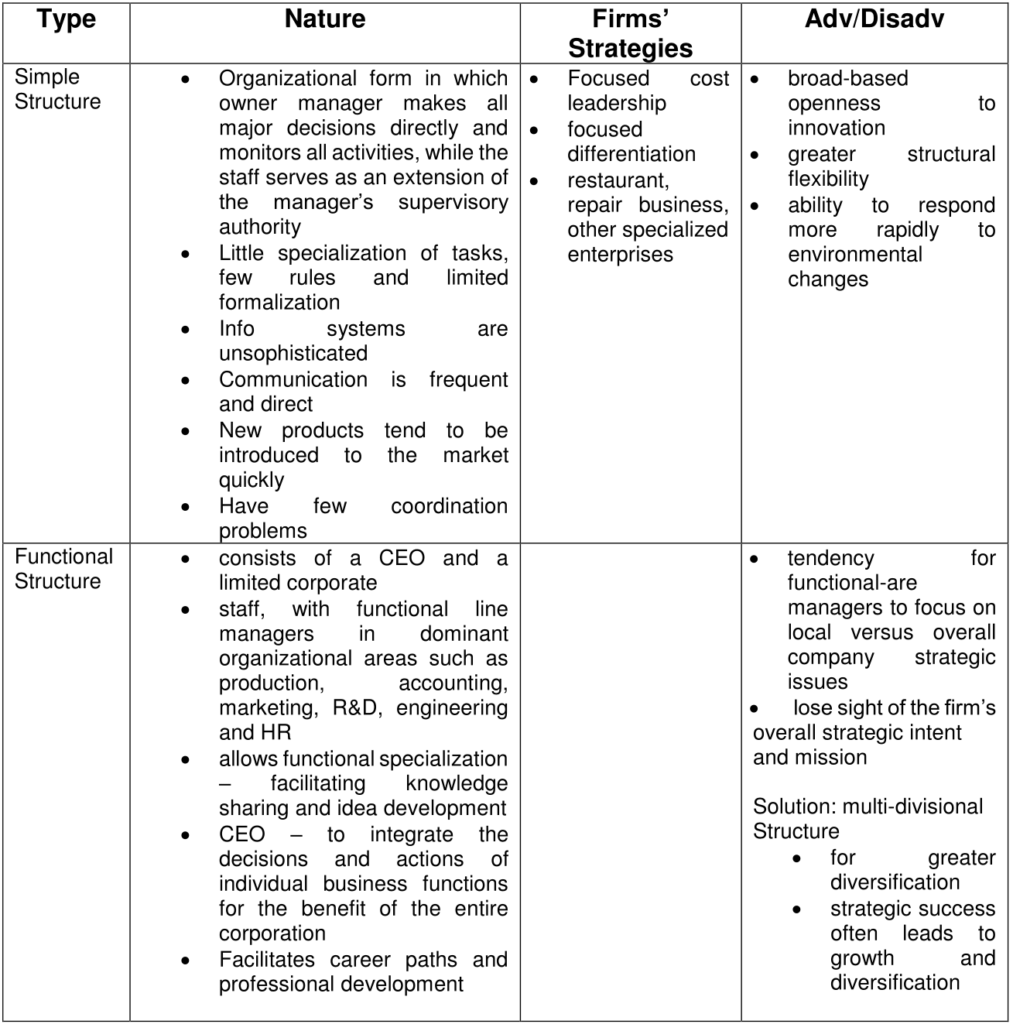
Definitions:
- specialization – type and number of job specialties that are required to perform the firm’s work
- centralization – the degree to which decision-making authority is retained at higher managerial levels
- the trend is towards decentralization – decision-making authority down to people who have the most direct and frequent contact with customers
- formalization – the degree to which formal rules and procedures govern organizational activities
Structures for generic Strategies
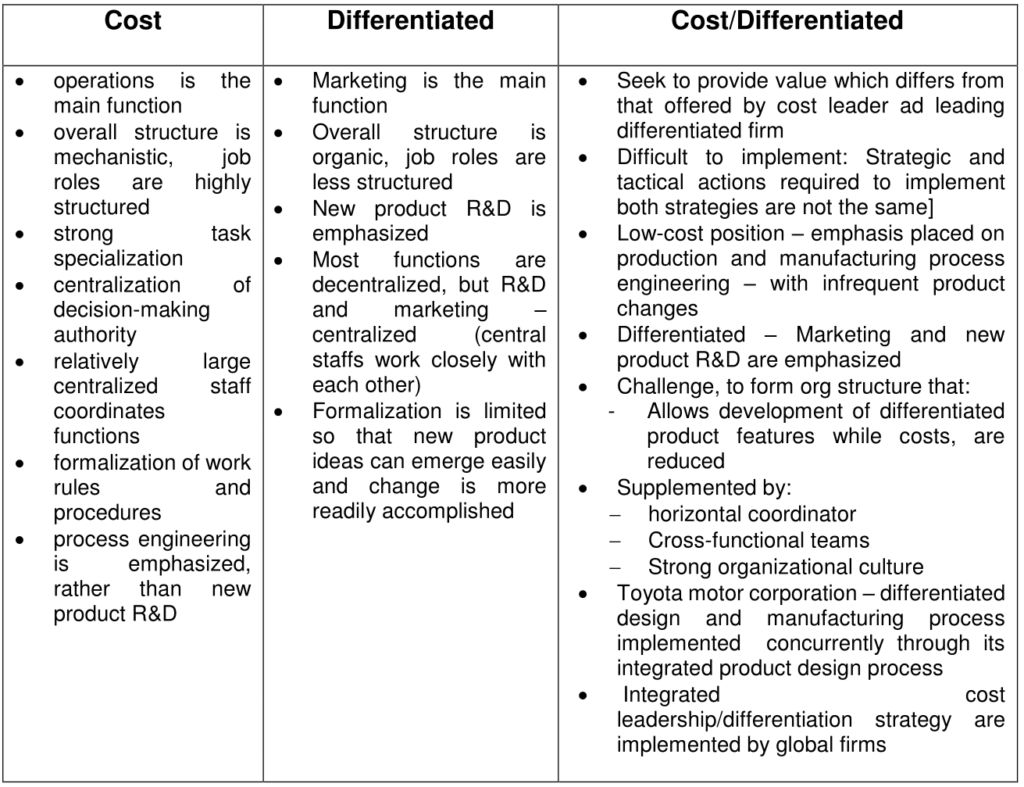
Multi Divisional Form
| Cooperative Form | Strategic Business Units (SBUs) | Competitive Form | |
| Definition | Cooperative form – uses many integration devices and horizontal HR practices to foster cooperation and integration among the firm’s divisions | Consists of at least 3 levels, the top-level being corporate HQ, the next, SBU groups, and final level, divisions groups by relatedness (through either a product or a geographic market) within each SBU | Controls used emphasize competition between (usually unrelated) divisions for corporate capital |
| Characteristics | Structural integration devices crate tight links among all divisions. The corporate office emphasizes centralized strategic planning, HR, and marketing to foster cooperation between divisionsR&D – likely to be CentralizedRewards are subjective and tend to emphasize overall corporate performance, in addition to divisional performance. Culture emphasizes cooperative sharing | Structural integration among divisions within SBU’s, but independence across SBU’sStrategic planning – the most prominent function of HQ for managing the strategic planning approval process of SBU’s for the CEOEach SBU may have its own budget for staff to foster integration]Corporate HQ staffs serve as consultants to SBUs and divisions, rather than having direct input to product strategy, as in the cooperative form | Corporate HQ has small staff Finance and auditing – most prominent functions in HQ to manage cash flow and ensure the accuracy of performance data coming from division legal affairs function becomes important when the firm acquires or divests assets. Divisions: independent and separate for financial evaluation purposes to retain strategic control, but cash is managed by the corporate office |
| Centralization | Centralized at corporate office | Partially centralized (SBUs) | Decentralized to divisions |
| Use of integration mechanisms | Extensive | Moderate | Nonexistent |
| Divisional performance appraisal | Emphasizes subjective criteria | Uses of a mixture of objective and subjective criteria | Emphasizes objective (Financial or ROI) criteria |
| Divisional incentive compensation | Linked to overall corporate performance | Mixed linkage to corporate, SBU and divisional performance | Linked to divisional performance |
| Example | IBM – facilitating e-commerce services | Sony, GE – integration among divisions within SBUs but independence between SBU’s, NBC | Pacific Dunlop – Australia’s most diversified company; strategy – market a multitude of brand name consumer products as a mass retailer – with emphasis on brand’s equity and profitability |
The effect of structure on strategy:
M-form is a structural innovation intended to help managers deal with coordination and control problems created by increasing product and market variety
The disadvantage of M-form:
- Encourage inefficient levels of diversification
- Lack of focus
- A decrease in the diversified scope of M-form firms was associated with an improvement in shareholder wealth
Implementing International Strategies:
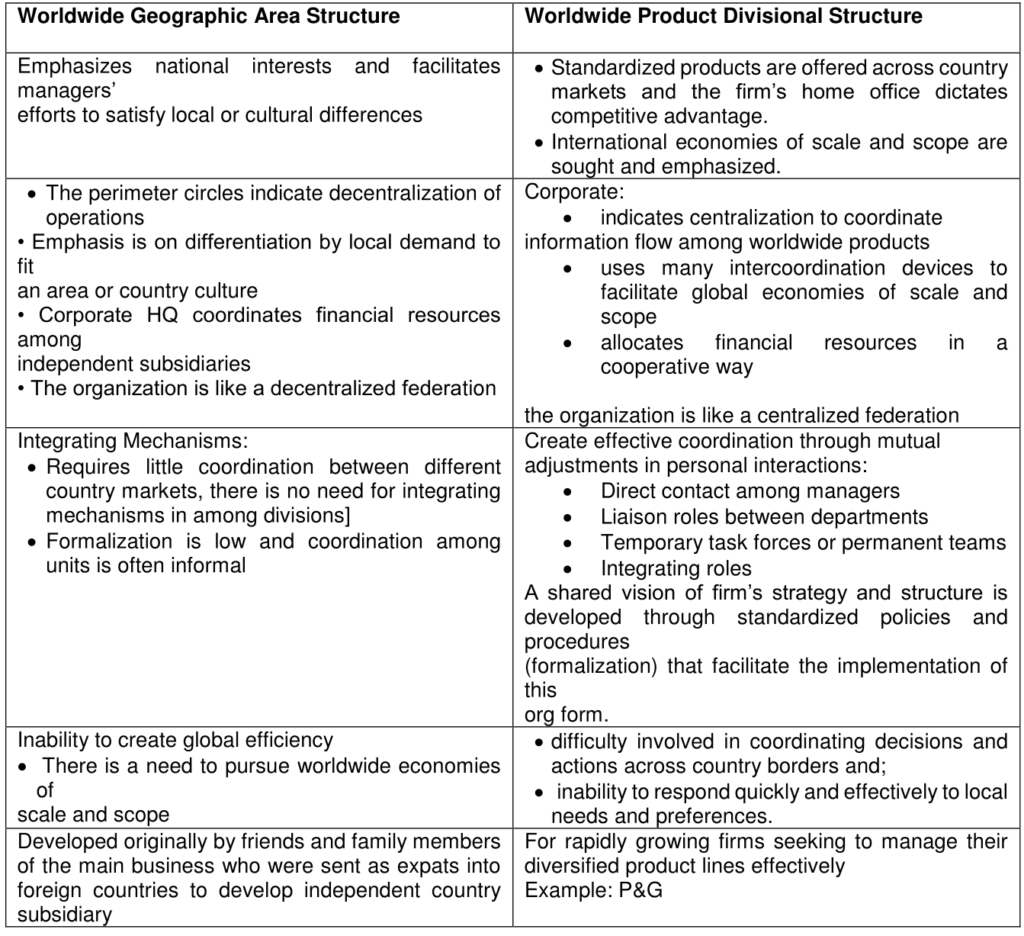
Transnational Strategy
- Using a combination structure of geographic and product division
- Firms seek to provide the local responsiveness that is the focus of multi-domestic strategy and to achieve the global efficiency that is the focus of the global strategy
- Emphasis on both geographic and product structures
Building Organizational Capabilities
Work environments help shape the values and skills of future leaders and promote continuity over time. It is the personality of the company. It is distinct. They are what gives meaning to work and what provides a basis for individuals to identify with the company. Provide shared but implicit decision criteria.
Tailoring the organization to strategy
The structure must be tailored to the relevant aspects of corporate strategy and current conditions for people to contribute creatively and effectively to the performance of the enterprise. Steps involved, approached in parallel or even reverse order:
- Key tasks to be performed and the kinds of decisions required for its implementation must be identified
- Responsibility for key tasks and decisions must be assigned to individuals or groups in a manner that permits their efficient performance. Understanding the capability of the people and subunits of the company relative to the competition is vital
- Formal provisions for the coordination of activities thus separated must be made in various ways
- Information systems adequate for coordinating divided functions must be designed and installed
- tasks to be performed need to be arranged in a sequence comprising a program of action or a schedule of targets to be achieved at specified times
- Once the basic structure is settled, individuals and teams must be recruited and assigned to essential tasks in accordance with the skills that they possess or can develop
- Actual performance as described by formal reports and assessed by managers and customers must be compared with plans and standards in order to measure organizational achievement, individual and subunit competence, and the adequacy of internal standards;
- The compensation and incentive schemes of the company need to be examined to ensure that the way individual performance is measured in both quantitative and qualitative terms is aligned with the corporation’s goals
- “Boundary systems” of constraints and controls like incentives which are both formal and informal, must be devised to contain inappropriate activity and enforce standards, especially ethical standards
- Provision for the continuing development of required technical and managerial skills, in the context of their responsibilities, is a high priority beyond the skills of special training and development needed for the implementation of a reorganization
- Energetic leadership is necessary for growth and achievement in any organization.
Building organization capability
- Effective CEOs or GMs lead strategy and implementation but provides others with opportunities to influence them. If people within tge organization believe that top management is open to listen to influence, they will go out of their way to report the opportunity and seek whatever communication channels are open to them.
- Tap the latent energy and creativity its employees bring to the job, they must be involved in the processes that shape the strategic aspects of their work (Involvement)
- Capital budgeting decisions to manage cash
- Problem-solving teams to address pressing issues as well as find opportunities to grow.
- Delegation and empowerment as the major organizing principle
Organizational capabilities of CEOs
As CEO or GM build new capabilities, they must attend to maintaining and renewing old ones from time to time. If maintenance is neglected, core organizational capabilities erode. If renewal activities are absent, the capability may become obsolete.
Basic skills are maintained at the same time new systems of offense and defense are developed and deployed. Capabilities:
- Organizational resources
- Organizational competencies
- Organizational capabilities
- How the organization knows how to do
organizational culture or work environment
- Values
- Beliefs
- Attitudes
- Practices
- Behavior patterns and skills that are the manifestation of how the organization do business
The work environment addresses issues:
- Maintaining outward orientation towards customers, competitors, suppliers
- Avoiding complacency
- Establishing the appropriate balance between teamwork and star contributors
- Necessity of shared response
Strategy and Organizational Planning
- The organization is more than just structure
- All of the elements of the organization must ‘fit’ to be in ‘harmony’ with each other
- Effective organization is that has blended its:
- Structure
- Management practices
- Rewards
- People
- That, in turn, fits with its strategy
- High performers are those who have achieved a fit between their strategy and their organization
Strategy and organization
Company’s culture is shared by where it began in the industry chain
| Upstream | Downstream |
| Standardize/homogenize: Producers of standardized commodity products | Customize/segment |
| Low-cost producer | High margins/proprietary positions |
| Process innovation | Product innovation |
| Capital budget | R&D / advertising budget |
| Technology/capital intensive | R&D/marketing dominated |
| Supply / trader / engineering | Line / staff |
| Maximize end users | Target end-users |
| Sales push | Market pull |
Strategic Change
- Vertical integration
- Diversification
- by-products diversification – sell by-products form points along the industry chain
- related diversification – diversifies into new businesses, but they are all related
- linked diversification – involves moving into new industries and operating at different centers of gravity in those new industries but there is a linkage of some type among various businesses
- Unrelated diversification – into unrelated businesses
- Center of gravity change – stay in the same industry but change its center of gravity in that industry
Strategy, Organization, And Performance
| Strategy | Structure |
| Single business | Functional |
| Vertical by-products | Functional with P&L |
| Related businesses | Divisional |
| Linked businesses | Mixed structures |
| Unrelated businesses | Holding company |
- Functional with P&L
- functional but the sequential stages are often operated as profit and loss divisions
- centralized and run by collegial management groups
- Related businesses
- adopt decentralized profit center divisions
- usually have strong corporate staffs and some centralized marketing, manufacturing and R&D
- Holding
- Outstanding feature: small corporate staff – support staff
- Marketing, manufacturing and R&D decentralized to the divisions
- The high performers are consistently the related diversifiers:
- All downstream companies in businesses with high R&D and adverting expenditures
- Have higher margins and returns than other businesses
- Not the strategy but the businesses the relateds happen to be in Relateds versus unrelated
- Relateds:
- Ability to learn a set of core skills and an organization to perform a particular center of gravity
- Get diversified portfolio but with a system of mgt and organization that is understood by everyone
- Unrelated – have to learn new industries and how to operate to a different center of gravity
- Encounters control troubles
Leadership, Ideology and Organizational Culture
Coming to a New Awareness of Organizational Culture by Edgar H. Schein
Basic Underlying assumptions under which cultural paradigms form
The organization’s relationship to its environment, the relationship of humanity to nature, view relationship as dominance submission, harmonizing and finding an appropriate niche. The nature of reality and truth – linguistic and behavior rules that define what is real and what is not. The nature of human nature – what does it mean to be ‘human’; what attributes are considered intrinsic or ultimate. The nature of human activity – what is the ‘right’ thing for human beings to do
e. the nature of human relationships – what is considered to be the ‘right’ way for people to relate to each other
The Strength of a Culture is defined in terms of the homogeneity and stability of group membership, the length, and intensity of shared experiences of the group. Long, varied, intense history has a strong and highly differentiated culture. Very young companies would be judged as having a weak culture. New members can be strongly socialized into the organization – e.g. elite military units
Cultural strength may or may not be correlated with effectiveness. Young groups strive for cultural strength – as a way of creating an identify themselves. Older groups have weak total culture and diverse subcultures to be responsive to rapid environmental change.
If a total corporation consists of stable functional, divisional, geographic, or rank-based subgroups; have multiple cultures within. Cultural assumptions can come from the occupational background of the members of the group
Invented, Discovered Or Developed
Leadership must not only ensure the invention of new and better solutions but must also provide some security to help the group tolerate the anxiety of giving up old, stable responses, while new ones are learned and tested – Lewinian change framework of unfreezing stage
Problems of external adaptation and internal integration
External adaptation problems.
- Those that ultimately determine the group’s survival in the environment
- While prior cultural experience predisposes members to perceive the environment in a certain way and even to control that environment to a degree, there will always be elements of the environment that are clearly beyond the control of the group and that will, to a degree, determine the fate of it
- Problems: – Strategy – developing consensus on the primary task, core mission or manifest and latent functions of the group.
- Goals – developing consensus on goals – goals being the concrete reflection of core mission.
- Means for accomplishing goals – like division of labor, organization structure, reward system
- Measuring performance – in measuring how well the group is doing against its goals and targets
- Correction – consensus on remedial or repair strategies needed when the group is not accomplishing its goals
2. Internal Integration
- group/organization cannot survive if it cannot manage itself as a group
- Issues of internal integration around which cultural solutions must be found:
- Language – common language and conceptual categories
- Boundaries – inclusion and exclusion; who is in or who is out – by what criteria one determines membership
- Power and status: a. work out its pecking order and its rules for how one gets, maintains, and loses power crucial: helping members manage their own feelings of aggression
- Intimacy – criteria for intimacy, friendship, and love
- Peer relationships
- For relationships between sexes
- Manner in which openness and intimacy are to be handled in the context of managing the organization’s tasks
- Rewards and punishments – what is heroic or sinful behaviors
- Ideology – on ideology or religion
Taught to new members
Because culture serves the function of stabilizing the external and internal environment for an organization, it must be taught to new members for culture to serve its function. It must be perceived as correct and valid. It must be taught to newcomers. New members do bring new ideas and do produce cultural change, esp if they are brought in at high levels of the organization
Through the role of innovation, the process of socialization is important. If culture provides a paradigm of how the world ‘is’, such a paradigm would be passed on without question to new members. Very process of passing on the culture provides an opportunity for testing, ratifying and reaffirming it. Culture is pervasive and ubiquitous. The longer we live in a given culture, the older the culture is, the more it will influence our perceptions, thoughts, and feelings
The study of Organizational culture and its implications
Four approaches to gathering data and decipher paradigms – a pattern of assumptions underlying culture
- the process and content of socialization of new members
- Analyzing responses to critical incidents in the organization’s history
- Analyzing beliefs, values and assumptions of “culture creators or carriers”
- Jointly exploring and analyzing with insiders the anomalies or puzzling features observed or uncovered in interviews
Implications for culture management and change. Evolutionary perspective draws attention to the fact that the culture of a group may serve different functions at different times
- Forming and growing group – culture is a “glue” – a source of identity and strength
- Culture changes – clarification, articulation, and elaboration
Organizational midlife Culture can be managed and changed, but not without considering all the sources of stability identified above. Whether to enhance diversity or create a more homogeneous “strong” culture – becomes one of the toughest strategy decisions management confronts especially if senior management is unaware of some of its own cultural assumptions
Stage of maturity and decline. From mature markets and products or from excessive internal stability and comfort that prevents innovation may need to change parts of their culture provided they obtain the necessary self-insight. Painful process and will elicit strong resistance.
No single model of such change exists. Orchestrate change from outright coercion at one extreme to subtle seduction through the introduction of new technologies at the other extreme
Organizational Culture
Culture is the meta-strategy of how the firm will prosper in the industry.
What is culture?
Shared meanings transmitted from generation to generation. Collective “consciousness” of a human group. Covers the whole gamut of a group’s experience such as the relationship with God, Nature, Fellowmen.
Elements that differentiate a country’s culture from others.
- Suprastructure – values that are of Western origin (Individualistic
- Infrastructure – traditions and ethics that is indigenous (collectivistic)
- Hofstede
- Masculinity
- Uncertainty avoidance
- Power distance
- Strong or long-term orientation
- Individualism / collectivism
Key elements of culture
- Basic assumptions
- Shared by a group
- Assumptions have demonstrated validity
- They will be taught to newcomers
Cultural Materialism
- Culture is not divorced from reality
- Cultures not adapted by the group will eventually disappear
- Relating culture to adaptive “scenarios”
Culture transmission
- Socialization / initiation
- Imitation
- Formal or informal processes
Key functions of culture
- External adaptation
- Internal adaptation
- Provides a sense of identity
Internal Integration
- To ensure people to work together
- How power should be exercised?
- Who should hold power?
People create ‘culture’ – based on history, experience, and inspiration. It is born out of collective experiences. Cultures change – not static; depends on the interpretation of culture. Leaders particularly visionary and articulate leaders
- Define and institutionalize the organization’s culture
- Have disproportionate share/influence of how cultures are defined in the organization
Reinforcement of Culture
- What leaders pay attention to, measure and control
- Leaders’ reaction to critical indicators and organizational crises
- Deliberate role modeling, teaching and coaching by leaders
- Criteria for recruitment, selection, promotion, retirement, and ex-communication (not just in the manual)
Secondary articulation and reinforcement mechanisms:
- Organizational design and structure
- How does the org design ensure ‘fidelity’ to culture?
- Organizational systems and procedures
- Design of physical space, facades, and buildings
- Stories, legends, myths, and parables about important events and people
- Formal statements of organizational philosophy, creeds, and charters
Conflicts should be resolved by reason not by use of power or power. Power must be used in a transparent and reasonable manner
Benefits of a strong culture
- Widely shared versus not widely internalized
- Monolithic / fragmented (subcultures)
- Explicit/implicit
- Systematically inculturated / not inculturated
- organizational ideology i. rationalizes/legitimizes the company’s way of doing things is oftentimes reflected in the mission statement
- is articulated by the leader
- influence behavior of all members of the organization
- a strong unifying force
- can outlive the leader
Downside of culture
8. Resists change
9. Can influence thought, feeling and action even when it is no longer adaption to current conditions
10. “has a power of its own…”
The downside of culture is when the culture is no longer adaptive….
Politics, Power & Influence in organization
Basic Methods for acquiring and maintaining power & Power, Dependence, and Effective Management by John P. Kotter
How managers do behave in their quest for power?
Gain control over tangible resources?
How do effective managers acquire power?
How and for what purposes do effective managers use power?
Dependence in the manager’s job
Manager can be dependent in varying degrees on:
- Superiors
- Subordinates
- Peers in other parts of the organization
- Subordinates of peers
- Outside suppliers
- Customers
- Competitors
- Unions regulating agencies
Dependency relationships are an inherent part of managerial jobs because of two organizational facts of life:
- Division of labor
- Limited resources
- Divided into specialized divisions, departments, and jobs
- Directly or directly dependent on others for information, staff services, cooperation from suppliers, competitors, unions, regulatory agencies, and customers to achieve organizational objectives
Managers may find themselves dependent on people whom they do not directly control and. who are not ‘cooperating’. As a person gains more formal authority in an organization, the areas in which he or she is vulnerable increase and become more complex rather than the reverse, Persuasion alone will not work – has some serious drawbacks.
“it is primarily because of the dependence inherent in managerial jobs that the dynamics of power necessarily form an important part of a manger’s processes”
Acquiring power
Means acquiring potential influence
- Potential for getting others to do what you want or
- For preventing them from forcing you to do something
Forms of Acquiring Power: RIR (resources-information-relationships)
- Gaining direct control over tangible resources – the most obvious way of such potential
- Tangible resources (Budgets, Employees, Buildings, Equipment). Resources put managers in a better position to influence others or to acquire other types of power.
How to gain control over resources
- Performing their jobs in ways their superiors judge to be particularly good i. Resources tend to flow to high achievers
- The good performance allowed a manager to receive additional staff positions
- Tactic: identify and acquire a managerial position that may not formally seem very powerful but that can potentially control many scarce resources and by being sensitive to the effect on resources of all the decisions they make
Obtaining information and control of information channels
Control of useful information and information channels. Even more important than tangible resources. Rational problem solving and influence by persuasion are essential in complex settings. Control of scarce information on:
- What motivates specific people
- On outcomes
- Processes related to organizational goals
- Can enhance problem-solving ability
- Thus, information is power
Establishing Power In Relationships
To help cope with the dependency relationships inherent in jobs. Effective managers:
- Create
- Increase
- Maintain four different types of power over others
- focus on relationships – an exercise in developing some type of credibility
Creating a sense of obligation
When a manager is successful, the other feels that they should allow the manager to influence them with certain limits
- Getting other people to feel obligated in certain ways
- Most people believe friendship carries with it certain obligations, managers sometimes try to develop friendships, especially with powerful superiors Make formal and informal deals in which they make concessions in exchange for certain future obligation
- Successful managers: can identify and implement actions that are good for both them and their organizations.
Manager’s Expertise: Building a good professional reputation
Building a reputation as an expert in certain matters. People will offer to defer to the manager because they believe in the manager’s expertise.
Established through visible achievement
- The larger and more visible the achievement, the more power the individual tends to develop
- Visibility is important in large settings – where people have secondhand information about the professional and competence of others such as Scientific papers and managerial articles – more credibility, “Professional reputations” and “Track records.”
- Today’s better-educated managerial workforce has greater respect for expertise
Identification with a Manager / Encouraging identification
Fostering others’ unconscious identification with them or with ideas they “stand for”. Seen in the way people relate to charismatic leaders. The more a person idealizes a manager, both consciously and unconsciously, the more he/she will defer to that manager. People generally need to look up to someone who can make them feel strong and confident despite all the problems that they face and who can help them feel they are doing something meaningful – especially if their jobs seem trivial or pointless
Perceived Dependence on a Manager / Creating perceived dependence
By feeding others’ beliefs that they are dependent on the managers for either help or security. The more dependent other people perceive themselves to be, the more they will be inclined to cooperate with such managers.
Methods in Finding & Acquiring Resources.
The manager identifies and secures resources that another person requires to perform his job.
Resources include
- Authority to make certain decisions
- Control of money, equipment, and office space
- Access to important people
- Information and control of information channels
- Subordinates
The manager controls resources that others need but which they neither possess nor can readily acquire elsewhere. The manager takes action so that the other person correctly perceives that the manager has such resources and is willing and ready to use them to help (or hinder) the other person.
Affecting Perceptions of Resources:
- Influencing other people’s perceptions of a manager’s resources
- Managers should pay attention to the “trappings’ of power and to their own reputations and images
- Associate with people or organizations that are known to be powerful or perceived as powerful
- “He seems to have a strong and unique relationship with the chairman of the board. They had lunch together rather often.” – considerable attention to the trappings of power
Keys to success at acquiring power
Sensitive to what others consider to be legitimate behavior in acquiring and using power a. Recognize that the four types of power carry certain ‘obligations’ regarding the acquisition and use. Tend to be very sensitive to where power exists in their organizations. Have a good intuitive understanding of the various types of power and methods of influence
- Who really controls resources and information
- What important interpersonal relationships are
- What people are really dependent upon
- Politically sensitive – cannot acquire power efficiently
Too much time and effort would be wasted looking for resources in the wrong places and developing relationships with the wrong people. Might accidentally offend a very powerful person or a key individual who must be depended upon.
To some degree, they use all the methods described (resources – information – relationships) to develop power
Ignoring any method – means reducing the amount of power that can be developed and putting themselves in a vulnerable position
Take calculated risks in which they ‘invest’ some of their power in the hopes of gaining it back with interest.
Recognize that all of their actions can affect their power and they avoid actions that will accidentally decrease it a. Calculate the consequences of any action not only in terms of its organizational impact but also in terms of its effect on their power
In their career development, they try to move both up the hierarchy and toward positions where they can control some strategic contingency for their organization
Power and Politics
The Rationale Of Power & Politics In Organization
- CEO to succeed in implementing strategies
- Using power to influence other people
- Assess how to successfully implement strategies
- Use power whom to convince
- Convince who? – Significant investment: Board of Directors
- BOD – owns the firm / outstanding stocks; convince the members who have significant influence;
- Understand how the board would decide on the proposal
- How is it usually done? Process in soliciting approval?
- Politics and power matter – how to convince the board to sway on his side?
- Ownership = Power
- Strategy:
- Choose the most influential
- Using an endorser – insider of the Board
- CFO who is a member of the board
- Endorser – outside the Board; Wife of the chairman of the Board
- Insider – familiar with the project
- Be able to have it approved so that it will be implemented
- Approach outsider – who can help the members of the Board
- Many types of relationship
Sources of Power
- Ownership
- Finance person outside the Board room; if well-respected by the owners
- Trusted by owners even without titles; earned through personal characteristics: integrity – proven through performance in the organization; know what you are doing;
- knowledge of the business;
- an honest person without vested interests
- Who can influence the final decision in the firm? = Power
Managers must recognize the influential persons in an organization in order to determine their role in the firm’s operations and performance. Some types of power are the following:
- Legitimate Power – Power as defined by the position occupied by a person. comes by virtue of a person’s occupying a position in an organization
- Expert Power – Arises from expert knowledge and do not need a position. Capacity to influence which arises from expert knowledge.
- Referent Power – Results from some personal characteristics of a person (charisma). The power that comes by virtue of some personal characteristic “charisma” of the person which others identify with
- Reward power – The power of a person to give or withhold resources. The power that comes by virtue of a person’s ability to give or withhold resources which are valued by others. When you can give rewards, you have power.
- Punishment power – comes from the capacity of a person to deprive a person of something of value. Closely related to reward power; a power that comes from the capacity to deprive a person of something of value. E.g. If somebody can fire you
- Relationship power – comes from a system of informal personal obligations that has been built up between people. Comes from a system of informal personal obligations which has been built up between people. Need not have a formal title to have power over decision making .
Power, politics & influence of the CEO
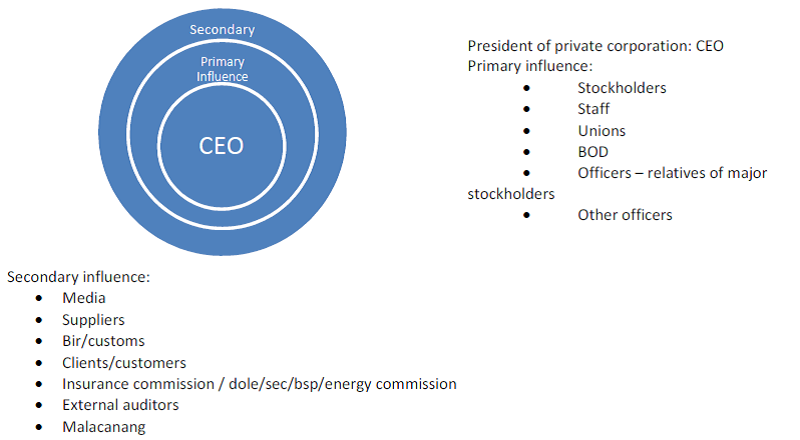
Managing your Boss
Mutual dependence requires the following:
That you have a good understanding of the other person and yourself, especially strengths, weaknesses, work styles, needs. That you use the information to develop and manage a healthy working relationship that is compatible with both persons work styles and assets. It is characterized by mutual expectations and meets the most critical needs of the other person
Managing the relationship with your boss:
Make sure you understand your boss and his context, including goals and objectives, pressures on the boss, strengths, weaknesses and blind spots, and preferred work style.
Assess yourself and your needs, including your own strengths and weaknesses, your personal style and your predisposition toward dependence on authority figures. Develop and maintain a relationship that fits both your needs and styles and is characterized by mutual expectations, keeps your boss informed, is based on dependability and honesty and selectively use your boss’s time and resources
International Expansion
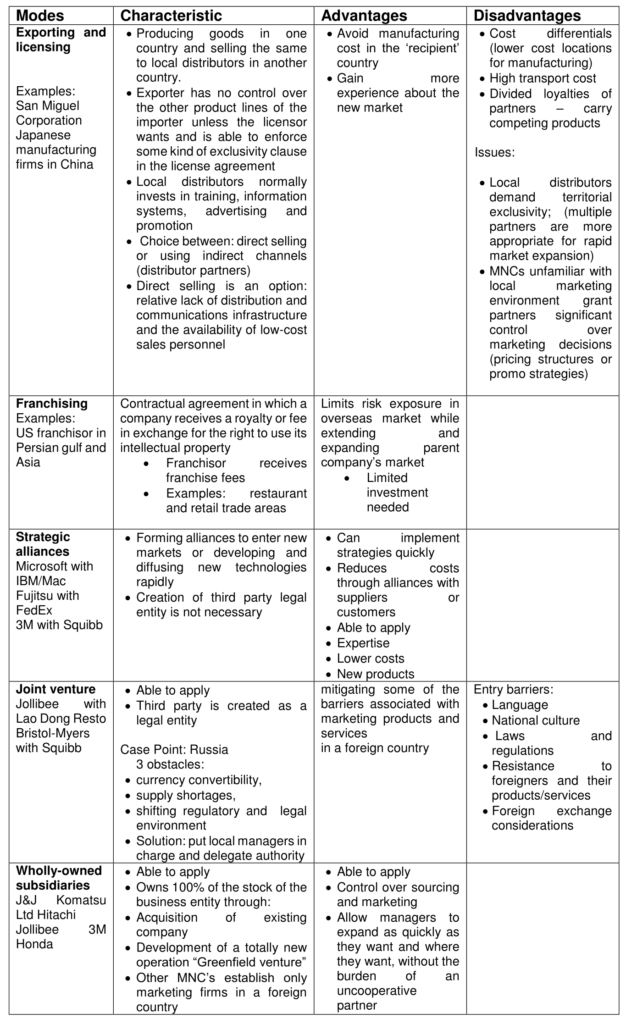
Conducting R&D in foreign countries
The international expansion enabled R&D to be near knowledge centers in foreign countries and to rapidly commercialize new products. Changing the role of managers from being managers of people and processes to be managers of knowledge
Responsibility for integrating global R&D network by performing activities such as setting research agenda, monitoring results, linking R&D sites to each other
Strategic objectives for maintaining R&D facilities in foreign countries:
- Locating in foreign countries to be near foreign universities
- Near competitors
- Where new products can be moved rapidly from development state to commercial stage
Establish a presence of various locations to access new knowledge and to absorb new research results from foreign universities and competitors into their own organizations. Companies must move new products from development to market at a rapid pace.
Home-base-augmenting site established to gather new knowledge for a company. Home-base-exploiting site supports to manufacture and market products by adapting products to local needs.
Building foreign plants or factories, Rationale/Strategic Roles:
Expansion mode to be implemented depends on the strategic objective for the expansion and must be appropriate to the foreign country market. Multi-National Companies must study Economic, Cultural, Legal/regulatory, Other factors in the host foreign country – that are crucial to the success of the firm’s foreign operations.
Foreign plants and factories not only serve as manufacturing or production sites but have evolved to play other strategic roles such as centers for product innovations and sources of products for regional markets. The increasing sophistication of manufacturing and product development and the growing importance of having world-class suppliers are reasons why some Multi-National Corporations’ place less emphasis on low wages when choosing foreign manufacturing sites.
Offshore or source factory should be located in places where:
- Product costs are relatively low
- Skilled workers are available
- Infrastructure relatively developed
Server or contributor factory
- Foreign factory supplies national or regional markets
- Scope includes product and process engineering
- To take advantage of low wages
Lead factory
Creates new processes, products, and technologies for the entire company. Initiates innovations in foreign countries
Tangible Reasons
- Cheap labor
- Reduced logistics costs
- Tariff and trade concessions and other incentives
- Skilled and talented employees
Intangible
Learning from foreign research centers, customers and suppliers. Example: a. 3M chose Bangalore – the advantage of suppliers, sophisticated competitors and skilled laborers
